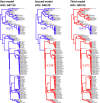Disparity of cycad leaves dispels the living fossil metaphor
- PMID: 38485767
- PMCID: PMC10940627
- DOI: 10.1038/s42003-024-06024-9
Disparity of cycad leaves dispels the living fossil metaphor
Abstract
The living fossil metaphor is tightly linked with the cycads. This group of gymnosperms is supposed to be characterised by long-term morphological stasis, particularly after their peak of diversity and disparity in the Jurassic. However, no formal test of this hypothesis exists. Here, we use a recent phylogenetic framework and an improved character matrix to reconstruct the Disparity Through Time for cycad leaves using a Principal Coordinate Analysis and employing Pre-Ordination Ancestral State Reconstruction to test the impact of sampling on the results. Our analysis shows that the cycad leaf morsphospace expanded up to the present, with numerous shifts in its general positioning, independently of sampling biases. Moreover, they also show that Zamiaceae expanded rapidly in the Early Cretaceous and continued to expand up to the present, while now-extinct clades experienced a slow contraction from their peak in the Triassic. We also show that rates of evolution were constantly high up to the Early Cretaceous, and then experienced a slight decrease in the Paleogene, followed by a Neogene acceleration. These results show a much more dynamic history for cycads, and suggest that the 'living fossil' metaphor is actually a hindrance to our understanding of their macroevolution.
© 2024. The Author(s).
Conflict of interest statement
The authors declare no competing interest.
Figures






References
-
- Darwin CR. On the origin of species by means of natural selection. London: John Murray; 1859.
-
- Turner DD. In defense of living fossils. Biol. Philos. 2019;34:23. doi: 10.1007/s10539-019-9678-y. - DOI
-
- Lidgard S, Love AC. The living fossil concept: reply to Turner. Biol. Philos. 2021;36:13. doi: 10.1007/s10539-021-09789-z. - DOI
Publication types
MeSH terms
Grants and funding
LinkOut - more resources
Full Text Sources

